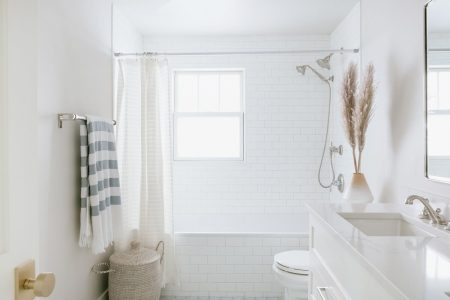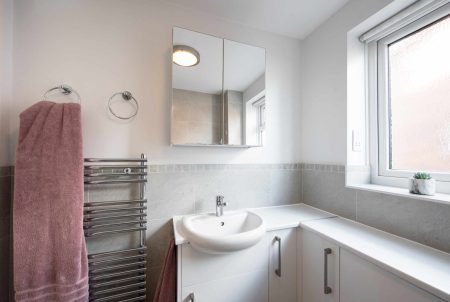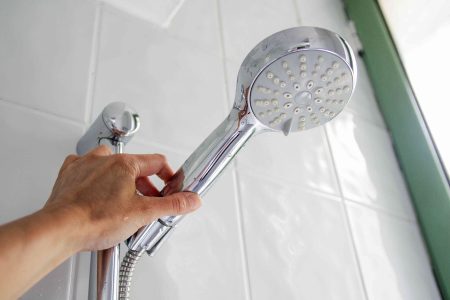All bathrooms are prone to moisture build-up. From easy-to-see surface issues like chipping paint and peeling wallpaper to hidden issues like mold and mildew or foul odors, improperly ventilated bathrooms are set up for failure. Whether you have a bathroom fan that’s undersized or one that’s clogged with dust and debris, there are several reasons your bathroom may be experiencing excessive moisture even after your steamy shower is over.
Below, we’ve done a deep dive into bathroom ventilation, including all the do’s and don’ts of bathroom ventilation, so you can preserve your bathroom’s atmosphere.
Signs of Bad Bathroom Ventilation
Improperly vented bathroom will have one or more of these telltale signs of excessive moisture:
- Humid air
- Mold
- Mildew
- Foul smells
- Peeling wallpaper
- Chipping paint
- Ceiling stains
- Soft or damaged flooring
- Condensation on vertical surfaces
If you have experienced any number of these moisture-related issues, it’s time to tackle your bathroom’s ventilation problems.
Warning
Improving your bathroom’s ventilation isn’t always enough to remedy established mold issues. Thoroughly clean the affected areas until all mold is removed for best results.
The Do’s of Bathroom Ventilation
To thoroughly vent the moisture from your bathroom, check each of these items off the list.
Do: Choose the Right Bathroom Fan
Properly venting your bathroom starts with choosing the right bathroom exhaust fan. Bathrooms come in all shapes and sizes and so do bathroom fans. One of the surefire ways to expose your bathroom to excessive moisture is to install an undersized exhaust fan.
Bathroom vent fans are rated in CFM, which stands for cubic feet per minute. This rating specifies how much air the fan can move over a set amount of time. As your bathroom’s square footage increases, your exhaust fan’s CFM must increase. Below, we’ve included a proper guide for determining bathroom exhaust fan size based on bathroom square footage:
- 45 square feet and less = 50 CFM
- 46 square feet to 75 square feet = 70 CFM to 80 CFM
- 76 square feet to 105 square feet = 110 CFM
- Over 105 square feet = 150 CFM fan
When in doubt, it’s better to have an oversized exhaust fan than an undersized exhaust fan.
Other Bathroom Fan Features
Beyond size, pay attention to energy efficiency, noise ratings, and any special features you desire, such as integrated lighting, heaters, and humidity sensors.
Do: Open the Window
If you have a bathroom window, open it for extra ventilation and fresh air flow whenever practical. However, you should still turn on your exhaust fan.
Opening the window will simply allow for more airflow when paired with an exhaust fan, as the fan will draw air into the window. The increased airflow will remove the excess moisture quicker than the running fan or open window alone.
Do: Wipe Up Standing Water
Leaving standing water in a tub, sink, shower, or even the floor is just setting up your bathroom to have humid air for an unnecessary amount of time. Even if your fan is on, the water will continue to evaporate and humidify the air until long after it’s gone. Always promptly wipe up standing water to avoid this fate.
Do: Install a Remote Inline Fan
If noise is of concern, consider installing an inline fan away from the bathroom. These fans are typically installed in a remote location such as an attic.
When turned on, an inline fan begins to suck air out of the bathroom just like a normal bathroom fan. However, because the fan is located far from the bathroom, the sound of the air movement is often all you will hear.
Do: Run Your Fan Long Enough
Yes, you should turn your bathroom fan on before you turn on the shower. However, you also must leave it on for several minutes after your shower to effectively remove the moist air from the bathroom. In some cases, it may be beneficial to leave your bathroom fan on for 30 minutes to one hour after getting out of the shower.
The Don’ts of Bathroom Ventilation
To prevent moisture buildup in your bathroom, avoid these bathroom ventilation mistakes at all costs.
Don’t: Install Your Fan in the Wrong Spot
A bathroom fan is only as effective as its location allows to it be, especially in larger bathrooms or bathrooms with divider walls.
For example, placing an exhaust fan above a toilet won’t effectively remove moisture from a shower that’s across the room. In this instance, it’s better to have a large, centrally located exhaust fan or two separate exhaust fans on opposite sides of the room.
Don’t: Leave Your Shower Door Closed
Leaving your shower door or curtain closed after use is like turning on a steam sauna in your bathroom. Not only will the surface water not dry, but the hot air will condense on the surfaces, causing more water to accumulate.
Don’t: Install Crushable Ductwork
Using crushable ductwork to vent your bathroom can result in eventually compromised ductwork. Because the ductwork that moves the air exiting your bathroom fan is typically located in attics, crawlspaces, or walls, it can be crushed by pests or other objects, which can hinder the airflow. To circumvent this issue, use rigid ductwork to vent your bathroom instead of soft, flexible ductwork.
Don’t: Forget to Clean the Fan
After only a few months of regular use, a bathroom fan can become clogged with dust and debris. The combination of the tight, thin fan blades and the moist air causes dust to cling to the rotating fan, building up over time. This will happen even quicker in older homes and homes with pets.
To ensure your fan is venting your bathroom properly, shut off the power to the fan at the breaker, then remove the cover and inspect the fan blades for buildup. If necessary, remove the fan and clean off the buildup.
Don’t: Vent Into the Attic
Many contractors and homeowners go to the trouble of installing a bathroom exhaust vent only to vent it into the attic rather than out of the house entirely. This is effectively moving the moisture problem from one area of the home to another.
If you vent a bathroom exhaust van into your attic, you should expect the same moisture-related issues you’d find in an improperly vented bathroom inside your attic, where it could spread to the rest of your home.
-
What is the best way to vent a bathroom?
The best way to vent a bathroom is to choose a properly sized exhaust fan and install it correctly according to the manufacturer’s specifications and your local building codes. Venting to an attic, using undersized, crushable ductwork, or installing ductwork with a complex exit path can cause excessive moisture buildup.
-
What happens if a bathroom is not vented properly?
If a bathroom isn’t vented properly, moisture will build up and cause issues like peeling paint, peeling wallpaper, stained ceilings, mold and mildew, bad smells, and more.
-
How much does it cost to install bathroom ventilation?
The cost to install bathroom ventilation ranges from $240 to $550, averaging $385. The cost directly increases as the CFM (cubic feet per minute) of the fan increases. This determines how much air the fan can move.
Read the full article here














